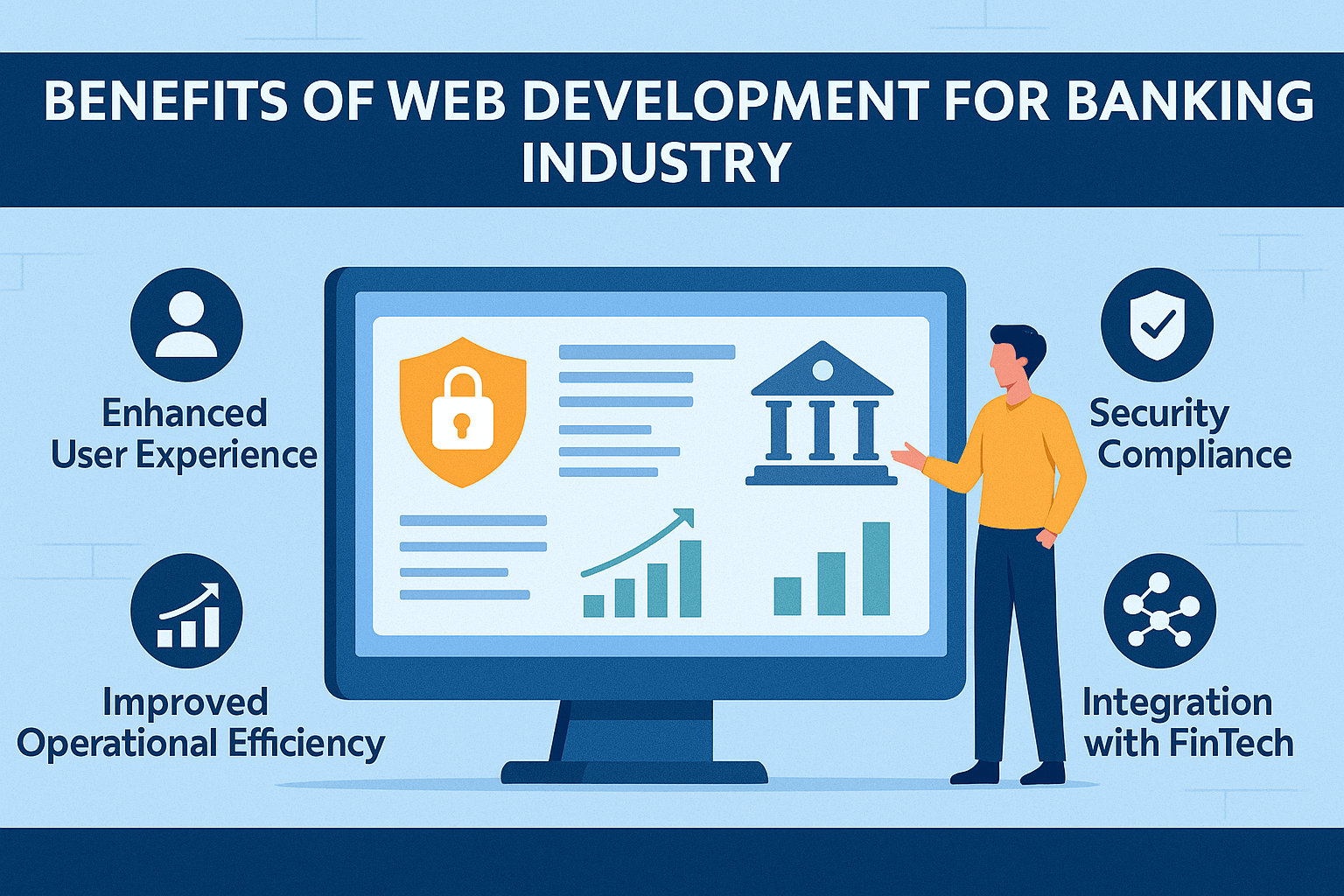
In the fast-paced world of finance, digital transformation is no longer an option—it’s a necessity. The banking industry is undergoing a seismic shift driven by technological advancements, customer expectations, and increasing competition from fintech startups. At the heart of this digital evolution lies one powerful tool: web development services.
A robust web development strategy doesn’t just mean having a sleek website—it’s about creating secure, scalable, and user-centric digital platforms that redefine how banks interact with their customers and streamline internal processes. This blog dives deep into why web development is critical for the banking industry, offering compelling reasons backed by statistics and reputable sources.
1. Enhanced User Experience & Customer Retention
Modern banking customers demand seamless, intuitive, and responsive digital experiences. Whether they are checking their account balance, applying for a loan, or transferring funds, customers expect 24/7 availability and smooth functionality.
According to a study by Statista, around 2.5 billion people globally used online banking services in 2024, and this number is projected to grow as smartphone and internet penetration increase (Statista, 2024).
Web development services play a pivotal role in:
- Building mobile-responsive and user-friendly interfaces
- Offering personalized dashboards
- Enhancing site speed and navigation
- Creating real-time chat and customer support features
A seamless experience ensures greater engagement, loyalty, and reduces churn rates. Research shows that 89% of consumers switch to a competitor after a poor digital experience (Forrester, 2023).
2. Security and Compliance Assurance
Security is paramount in banking. The volume of cyberattacks targeting financial institutions has increased significantly, particularly post-pandemic. In 2023 alone, the financial sector accounted for 22% of all cyberattacks worldwide (IBM, 2024).
Web development in banking goes beyond coding—it integrates data encryption, multi-factor authentication, firewalls, and compliance with regulations like:
- GDPR (General Data Protection Regulation)
- PCI-DSS (Payment Card Industry Data Security Standard)
- FFIEC (Federal Financial Institutions Examination Council) standards
A professional web development team ensures that banking websites and applications are built with best-in-class cybersecurity protocols, reducing the risk of breaches and ensuring compliance with international standards.
3. Boosts Operational Efficiency
Web development isn’t just about aesthetics—it’s also a tool for automation and optimization. Modern banks are leveraging web apps and platforms to automate time-consuming tasks such as:
- Account onboarding
- Loan processing
- Customer service via AI-powered chatbots
- Transaction tracking and reporting
According to McKinsey, banks that adopt digital-first strategies can reduce operational costs by up to 30% while improving customer satisfaction (McKinsey & Company, 2023).
With integrated APIs, databases, and dashboards, web development services help streamline operations, improve inter-departmental collaboration, and ensure real-time access to critical information.
4. Scalability and Flexibility for Future Growth
As banks grow, their platforms must scale to accommodate an increasing number of users, services, and data. With well-structured backend architecture and scalable cloud infrastructure—hallmarks of good web development—banks can evolve without frequent reengineering.
This flexibility allows for:
- Seamless integration of third-party fintech solutions
- Addition of new services like insurance, crypto wallets, or robo-advisory tools
- Multi-device and cross-platform compatibility
A modular web development approach allows banks to adopt new technologies such as AI, blockchain, and machine learning without overhauling their entire system.
5. Data Analytics & Personalization
Modern banking isn’t just transactional—it’s experiential and data-driven. Web development services help banks harness the power of customer data to deliver personalized experiences and targeted offerings.
Using built-in analytics dashboards, banks can monitor:
- Customer behavior and preferences
- Website traffic and usage patterns
- Real-time financial trends and forecasting
Personalized banking has become a key differentiator. A PwC study shows that 82% of banking customers are willing to share personal data in exchange for a more tailored experience (PwC, 2023).
Through intelligent web platforms, banks can offer tailored product recommendations, investment advice, or loan options based on a customer’s financial profile.
6. Improved Brand Image and Market Competitiveness
A well-developed website speaks volumes about a bank’s professionalism, reliability, and commitment to innovation. In today’s competitive landscape, your digital presence is your first impression.
Web development services help in:
- Designing brand-consistent UI/UX
- Ensuring accessibility and inclusivity
- Optimizing for SEO and voice search
- Integrating real-time reviews, testimonials, and trust signals
With over 60% of customers researching banks online before choosing a financial service, a sleek and functional website can be the difference between a lead and a lost opportunity (Think with Google, 2023).
7. Integration with FinTech and Emerging Technologies
FinTech partnerships are on the rise, and banks need dynamic web platforms to keep up. Web development services allow seamless integration of APIs and SDKs from:
- Payment gateways (Stripe, PayPal)
- Robo-advisors (Betterment, Wealthfront)
- Blockchain solutions
- KYC and AML tools
According to Deloitte, 73% of banks have increased their collaboration with fintech firms post-2020 to meet customer expectations and improve agility (Deloitte Insights, 2024).
Web platforms serve as the bridge between traditional banking and emerging tech, allowing for a smoother transition and reduced technical debt.
8. Omnichannel Banking Experience
Customers interact with banks via multiple touchpoints—websites, mobile apps, ATMs, and even voice assistants. Web development ensures consistency and connectivity across all these channels.
An omnichannel approach:
- Enhances customer satisfaction
- Provides a unified view of the customer journey
- Enables frictionless transitions between platforms
In fact, banks with strong omnichannel strategies retain 89% of their customers, compared to just 33% for banks with weak omnichannel experiences (Aberdeen Group, 2023).
Web development is the backbone that connects all these channels into one cohesive ecosystem.
Conclusion: Web Development is Not a Choice—It’s a Competitive Advantage
Web development has evolved from being a backend support function to a strategic growth driver for the banking industry. It empowers institutions to deliver secure, personalized, and efficient services while staying agile in a rapidly changing digital landscape.
From elevating user experience to ensuring compliance and enhancing operational performance, investing in professional web development services is not just important—it’s mission-critical for banks looking to thrive in the digital-first era.
Final Thought:
If you’re a decision-maker in the banking sector or a tech enthusiast exploring how financial institutions are adapting to digital transformation, it’s clear that web development is at the heart of banking’s future.






